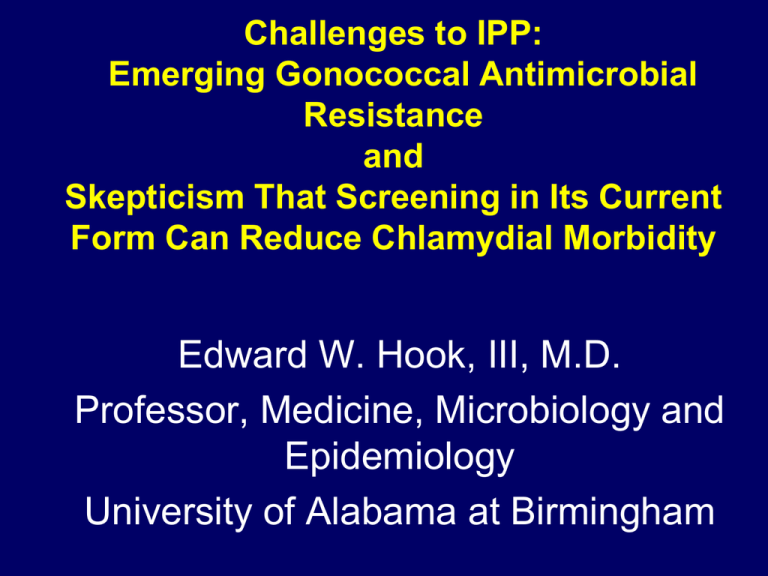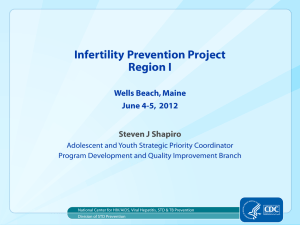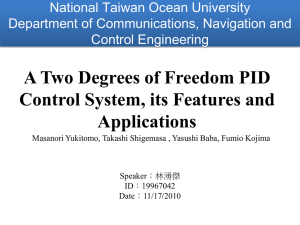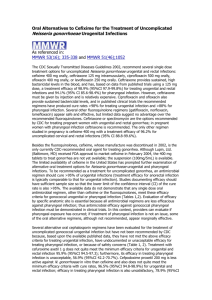
Challenges to IPP:
Emerging Gonococcal Antimicrobial
Resistance
and
Skepticism That Screening in Its Current
Form Can Reduce Chlamydial Morbidity
Edward W. Hook, III, M.D.
Professor, Medicine, Microbiology and
Epidemiology
University of Alabama at Birmingham
Emerging Gonococcal
Antimicrobial Resistance
Emerging Gonococcal Antimicrobial
Resistance – Deja Vu
Pre-1937
Antiseptic Irrigation With Potassium
Permanganate, Silver Salts,
Mercurochrome
1937
Sulfonamide Therapy
1943
Penicillin Therapy (Mahoney et al)
1944
35%Treatment Failure With Sulfonamides
1972
Penicillin Regimen Increased to 4.8 Million
Units Plus Probenecid
Emerging Gonococcal Antimicrobial
Resistance – Deja Vu
1976 Recognition of PPNG (AFRICA, S.E. ASIA)
1984 High Level Chromosomal Penicillin Resistance,
(Durham, N.C.)
1985 Recognition of Plasmid Mediated Tetracycline
Resistance
1987 High Level Spectinomycin Resistance, (Korea)
1989 Penicillin No Longer Drug of Choice for G.C.
2002 Concern Regarding Rising Quinolone MICs
Gonococcal Isolate Surveillance Project (GISP) — Location of
participating
clinics and regional laboratories: United States
Seattle
Portland
Minneapolis
Detroit
Philadelphia
Chicago
Denver
San F rancisco
Cleveland
Baltimore
Cincinnati
Las Vegas
Los Angeles
O range Co.
San Diego
G reensboro
O klahoma City
Long Beach
Albuquerque
Birmingham
Phoenix
Atlanta
Dallas
New O rleans
T ripler AMC
Honolulu
S TD Clinic s
Clinic s and
Regional Labs
Miami
Gonococcal Isolate Surveillance Project (GISP) — Percent of
Neisseria gonorrhoeae isolates with resistance to
ciprofloxacin by sexual behavior,
2001–2006
P ercent Ciprofloxacin Resistant
40
32
Heterosexual men
Men who have sex with men (MS M)
24
16
8
0
2001
2002
2003
2004
2005
2006
Gonococcal Isolate Surveillance Project (GISP) —
Percent of Neisseria gonorrhoeae isolates with
resistance or intermediate resistance to ciprofloxacin,
1990–2008
P ercent
16
Resistance
Intermediate resistance
12
8
4
0
1990
91
92
93
94
95
96
97
98
99
2000
01
02
03
04
05
06
Note: Resistant isolates have ciprofloxacin MICs ≥1 µg/ml. Isolates with
intermediate resistance have ciprofloxacin MICs of 0.125 - 0.5 µg/ml.
Susceptibility to ciprofloxacin was first measured in GISP in 1990.
07
08
200610 CDC STD TREATMENT
GUIDELINES
Uncomplicated Gonorrhea
• Ceftriaxone 250 125 mg IM
• or
• Cefixime 400 mg PO
• or
• Ciprofloxacin 500 mg PO*
• or
• Ofloxacin 400 mg PO*
• or
• Levofloxacin 250 mg PO*
•
Plus, IF CHLAMYDIAL INFECTION IS NOT RULED
OUT
•
Azithromycin 1.0 g Single Dose Or Doxycycline
100 BID x 7d
2010 CDC STD TREATMENT
GUIDELINES
Uncomplicated Gonorrhea
• Ceftriaxone 250 mg IM
• or
• Cefixime 400 mg PO
• PLUS
•
Azithromycin 1.0 g Single Dose or
Doxycycline 100 BID x 7d
"Those who cannot remember
the past are condemned to
repeat it."
George Santayana
Decreased Cephalosporin Susceptibility
1999
Japan: 0% isolates have MICs to cefixime ≥ 0.5 μg/ml
2001
Japan: Possible treatment failure with cefdinir
2002
Japan: 30% isolates have MICs to cefixime ≥ 0.5 μg/ml
2003
Japan: 8 (12%) of men with GC in study unsuccessfully
treated with cefixime
2007
Hong Kong: 4 treatment failures with cefixime
2008-2009
2010
Increasing MICs to cephalosporins reported in Australia,
Europe, and US
Japan: isolate with Ceftriaxone MIC of 2 µg/ml (female CSW)
Norway: 2 treatment failures with cefixime
Sweden: 1 pharyngeal GC treatment failure with
ceftriaxone 250 mg
Percentage of isolates
Distribution of MICs to Cefixime, 2005–2010*
Minimum Inhibitory Concentrations (MICs), µg/ml
* Preliminary (Jan-Sept)
Percentage of isolates
Distribution of MICs to Cefixime, 2005–2010*
1.3%
(n=58)
0.2%
(n=8)
Minimum Inhibitory Concentrations (MICs), µg/ml
* Preliminary (Jan-Sept)
Proportion of GISP isolates with MICs to
Cefixime ≥ 0.25 μg/ml, 2000–2010*
Percentage of isolates
Cefixime AST
not
conducted
* Preliminary (Jan-Sept)
1.5%
(n=66)
Proportion of GISP isolates with MICs to
Cefixime ≥ 0.25 μg/ml by Region, 2000–2010*
West
Percentage of isolates
Cefixime AST
not
conducted
3.7%
(n=57)
Midwest
N’east
& South
* Preliminary (Jan-Sept)
Proportion of GISP isolates with MICs to
Cefixime ≥ 0.25 μg/ml by Sex of Sex Partner,
2000–2010*
MSM
Percentage of isolates
Cefixime AST
not
conducted
4.7%
(n=56)
MSW
* Preliminary (Jan-Sept)
Percentage of isolates
Distribution of MICs to Ceftriaxone, 2006–2010*
Minimum Inhibitory Concentrations (MICs), µg/ml
* Preliminary (Jan-Sept)
Percentage of isolates
Distribution of MICs to Ceftriaxone, 2006–2010*
Minimum Inhibitory Concentrations (MICs), µg/ml
Pre
* Preliminary (Jan-Sept)
Gonorrhea — Rates by state: United
States and outlying areas, 2008
48.3
12.7
7.3
22.4
32.7
58.4
12.5
108.7
47.1
23.7
82.3
84.7
88.7
169.4
56.9
89.0
160.9 138.2
18.0
70.5
77.3
81.9
41.2 134.0
136.3
107.2
G u a m 6 2 .8
54.4
71.2
143.3
146.5
176.3
142.6
159.2
214.2
256.8
210.5
Rate per 100,000
population
170.5
134.7
220.2
84.6
VT
6.0
NH
7.6
MA 33.0
RI
29.0
CT 80.0
NJ 61.0
DE 120.8
MD 118.6
DC 451.5
47.5
127.8
<=19.0
(n= 7)
19.1-100.0
(n= 24)
>100
(n= 23)
Pu e r to Rico 6 .9
Vir g in Is. 1 0 9 .3
Note: The total rate of gonorrhea for the United States and outlying
areas (Guam, Puerto Rico, and Virgin Islands) was 110.3 per 100,000
population.
Emerging Resistance of C. trachomatis to
Azithromycin, 2010??
Cured (%)/ Treated
•
•
•
•
•
Doxycycline +/Tinidazole
55 (95%)/58
Azithromycin +/Tinidazole
41 (77%)/53
•
Schwebke JS et al. CIC 2011;52: 163-170
p= 0.01
Skepticism That Screening in
Its Current Form Can Reduce
Chlamydial Morbidity
Or
Is IPP Working and Why Are U.S.
Chlamydial Rates Increasing
IPP Logic Model
1. Association of CT and GC with PID
2. Association of tubal factor infertility
with PID
3. Evidence that CT screening reduces
PID
IPP Logic Model- Arguments
1. Association of CT and GC with PID
Old data, association of other organisms
(anaerobes, M. genitalium) with PID
2. Association of tubal factor infertility with PID
3. Evidence that CT screening reduces PID
Etiologic Agents of Pelvic
Inflamatory Disease
1. Neisseria Gonorrhoeae
2. Chlamydia trachomatis
3. Mycoplasma genitalium (proposed)
4. Anaerobic Bacteria
5. Non-STD pathogens
Actinomycosis
Mycobacterium tuberculosis
Other
IPP Logic Model- Arguments
1. Association of CT and GC with PID
Old data, association of other organisms
(anaerobes, M. genitalium) with PID
2. Association of tubal factor infertility with PID
Declining PID rates, increasing CT rates
3. Evidence that CT screening reduces PID
Sources of Imprecision in PID
Diagnosis
1. Non-specificity of clinical PID
diagnosis
2. Decreasing emphasis on
hospitalization for PID management
3. Declining gonorrhea rates – milder
PID signs an symptoms?
Pelvic Inflammatory Disease:
Accuracy of Clinical Diagnosis
Sensitivity
Specificity
Lower Abdominal Pain
94%
Adnexal Tenderness
92%
Increased Vaginal D/C
55%
Fever > 38°
41%
Laporoscopic Confirmation in
529/814 (65%) Clinically
Diagnosed Cases
Prevention of Pelvic Inflammatory
Disease by Screening for Chlamydia
2607 at risk women randomized to screening
(N=1009) or usual care (N=1598)
645 (64%) were screened of whom 44 (7%) were
infected and treated
Pelvic Inflammatory Disease Incidence
Screening 9/1009 (8 per 10,000 women months)
Usual Care 33/1598 (18 per 10,000 women
months)
Relative Risk for Screening Group = 0.44
Scholes D, et al. NEJM 1996;334-1362-6.
IPP Logic Model- Arguments
1. Association of CT and GC with PID
Old data, association of other organisms
(anaerobes, M. genitalium) with PID
2. Association of tubal factor infertility with PID
Declining PID rates, increasing CT rates
3. Evidence that CT screening reduces PID
Studies conducted in high risk women generalized
to general population; occurrence of PID in
women following screening
U.S. Chlamydial Prevalence (NHANES),
14-39 YO Women, 1999-2008
Prevalence, % (95% CI)
5.0
4.0
3.0
2.0
1.0
0.0
1999-2000
2001-2002
2003-2004
2005-2006
Year
Data From Johnson and Berman in Modern Infectious Disease Epidemiology,
Kraemer and Kretzschmar Eds. 2010
2007-2008
IPP Logic Model- Arguments
1. Association of CT and GC with PID
Old data, association of other organisms
(anaerobes, M. genitalium) with PID
2. Association of tubal factor infertility with PID
Declining PID rates, increasing CT rates
3. Evidence that CT screening reduces PID
Studies conducted in high risk women generalized
to general population; occurrence of PID in
women following screening
Suggested Steps To Enhance IPP
1. Measure PID and infertility, the outcomes
of interest.
2. Efforts to expand testing
3. Consider new metrics to encourage
continuous quality improvement (CQI)
Accelerating Infertility Prevention With
Small Steps: CQI – Doing It Better
Optimizing Chlamydia Screening
•Targeting those who need screening
•Improving the process of chlamydial
screening
•Assuring Timely Treatment
Time To Treatment Following STD Screening,
JCHD STD Clinic
Gonorrhea
Chlamydia
18%
20%
28%
35%
54%
No Treatment Within 30 Days
Treatment Within 13 Days of Screening
Treatment Within 14-30 Days of Screening
45%
Chlamydial Culture Performance in Women
Without Other Indications for Therapy
Patients with positive screening cultures
81
Patients referred elsewhere for therapy
3
Patients without documented F/U or therapy
20/78
(26%)
PID at F/U
2/58 (4%)
Interval to treatment (N=58)
7 days
24%
14 days
50%
21 days
60%
28 days
81%
Hook et al. JAMA 1994; 272; 867-70
Pelvic Inflammatory Incidence Following
STD Screening
•
Baltimore STD Clinic – 2 (4%) of 58
•
UAB Emergency Dept.- 3 (4.5%) of 67
•
Birmingham STD Clinic – 2 (2%) of 115
Hook et al. JAMA 1994; 272: 867-70.
Bachmann et al. . Sex Transm Dis. 1999;26(9):496-499.
Geisler et al. Sex Trans Dis. 2008
Improving Chlamydial Screening
Through CQI: Potential Metrics
Optimization of time from screening to treatment
-Specimen transit time to lab
-TAT in the lab
-Time to recording of test results
-Time to notification of infected
persons
-Mechanisms for facilitating treatment
of persons with positive
screening tests
Evaluation and characterization of those who either do not
get test results or fail to return
Improving Chlamydial Screening
Through CQI: Potential Metrics
Infections diagnosed treated
Time from screening to treatment
Asymptomatic persons returning for rescreening at 6 months
APTIMA Combo 2 Sensitivity
C. Trachomatis N. Gonorrhoeae
Endocervical
Swab
94%
99%
Initial Void Urine
95%
91%
Clinician
Collected
Vaginal Swab
97%
96%
Patient Collected
Vaginal Swab
97%
99%
Changing Paradigms For Urogenital
Specimen Collection
Pre-NAAT’s: Specimen Quality Critical
- Endocervical Or Urethral Swabs
- Swab Order Impacts Test Results
: Culture > Non-Amplified Nucleic Acid
Detection > Antigen Detection
NAAT’s: More Forgiving Specimen Collection
- Vaginal Swab = Endocervical Swab >
Endocervical Swab > Initial Void
Urine
Arguments For Non-Invasive
STD Testing
Patient: Faster
: Less Uncomfortable
Provider: Faster
: Fewer Resources
Personnel
Specula
Examination Table
System: Testing At Sites Of Opportunity
: Patient Satisfaction
Populations for Whom Non-Invasive STD
Testing Have Been Used
Non-Health Care Settings
School Based Clinics
Incarcerated Youth and Adults
Military Recruits
Homeless Persons
- Street Outreach
- Shelters
Long Haul Truck Drivers
STD Incidence
R = BcD
R=
Reproductive Rate
B=
Infectivity
C=
Sexual Partner Selection
Parameters (rate and variability)
D=
Duration of Infectivity
Anderson, RM and May RM; Nature 1988;333:323-320
THE NEXT GREAT PLAGUE TO GO
Thomas Parran’s 5-Point Program For Syphilis Control – 1936
1. Case Finding – Serologic Screening Programs
2. Prompt Therapy
3. Contact Identification, Testing, and Therapy
4. Mandatory Serological Evaluations – Premarital
and Early Pregnancy
5. Public Education = Symptoms, Complications,
Treatment
Insanity is doing the same thing
over and over again and expecting
a different result.
Albert Einstein








